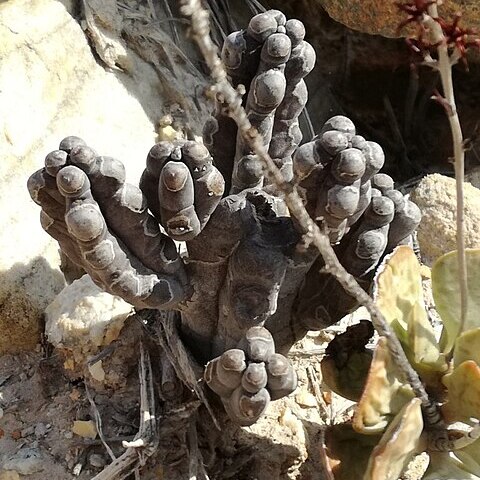Densely branched succulent shrublet usually broader than tall, up to 0.3 m tall and 0.3 m broad, rooting from central stem only and branching mainly above base. Stems 60-300 mm long, 15-30 mm thick, erect, purplish or greyish green; tubercles 3-5 mm long, broadly deltoid, laterally flattened, obtuse, joined in lower half into 4(rarely 5) obtuse angles along stem, each tipped with very small tooth <0.5 mm long or corky brownish patch flanked by 2 obtuse stipular denticles on new growth. Inflorescences of 2-15 ± simultaneously opening flowers usually in dense fascicles mostly in upper half of stem; pedicel 1.5-3.0 mm long, 1.5 mm thick, pinkish, spreading and holding flower facing horizontally; sepals 2-3 mm long, lanceolate-acute, pinkish. Corolla 13-15 mm long, narrowly campanulate; outside smooth and somewhat shiny purple-black on lobes to red on tube becoming cream towards base; inside dark purple-black on lobes and mouth of tube, in tube white with large round purple-black spots, with papillae around mouth of tube each tipped with a white ascending bristle; tube 3-4 mm long, 2.5-5.0 mm broad at mouth, cupular, with corolla slightly thickened at mouth; lobes 7.5-12.0 mm long, 3.5-4.0 mm broad at base, erect to spreading, narrowly lanceolate, acute, longitudinally folded back along middle. Corona ±1.5 mm tall, 2.0-2.2 mm broad, purple-black becoming white towards base, raised on short stipe; outer lobes ±0.5 mm long, ascending, shortly bifid into small spreading deltoid teeth, fused laterally for most of length with bases of inner lobes to form pouch; inner lobes ±0.5 mm long, adpressed to backs of anthers and exceeding them to meet in centre, ± rectangular, obtuse, dorsiventrally flattened, with broad and obtuse dorsal projection near base.
More
Like Q. linearis but larger, to 30 cm, and stems purplish to greyish green. Flowers usually in dense clusters opening simultaneously, reddish in centre with shiny blackish purple tips, papillate around mouth, inner corona lobes scarcely exceeding anthers and adpressed to them.
Like Q. mammillaris but densely branched shrub, up to 300 x 300 mm, stems 15-30 mm diam., with obtuse tubercles joined into 4, obtuse angles.

